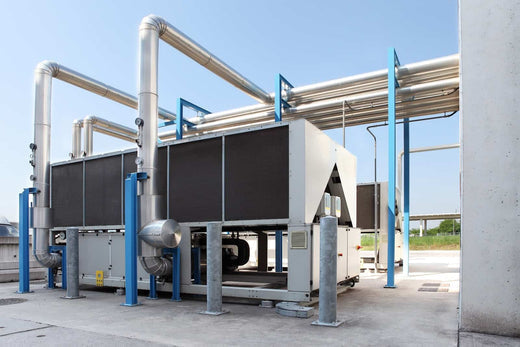
Potential Technologies Shaping the Indoor Air Quality with Air Handling Units Market
Share

Introduction
As concerns around health, comfort, and productivity continue to shape the modern building landscape, maintaining optimal indoor air quality (IAQ) has never been more critical. The global demand for efficient and effective heating, ventilation, and air conditioning (HVAC) systems is on the rise, with air handling units (AHUs) playing a central role in ensuring that buildings meet superior IAQ standards. The evolution of AHUs, driven by advancements in technology, is transforming HVAC systems into smart, energy-efficient, and highly effective solutions for improving air quality.
For investors looking to tap into the growing demand for smart, sustainable, and high-performance building systems, AHUs present a compelling opportunity. Let’s dive into the innovations that are driving the AHU market forward, highlighting how these advancements contribute to both better air quality and significant energy savings.
Smart HVAC Controls: Real-Time Monitoring for Optimized Performance
One of the most exciting developments in AHU technology is the integration of Internet of Things (IoT) and artificial intelligence (AI). These technologies empower AHUs with smart control systems that can monitor and optimize performance in real-time.
IoT-enabled AHUs allow for predictive maintenance, meaning that potential issues are identified before they become major problems, reducing downtime and repair costs. Additionally, AI-driven controls can adjust operation parameters based on factors such as occupancy levels, outdoor environmental conditions, and real-time IAQ measurements. This ensures that the system operates at peak efficiency, minimizing energy consumption while maintaining optimal air quality for building occupants. For investors, this opens up significant opportunities in the smart building and IoT sectors, where cutting-edge technology and sustainability converge.
Advanced Filtration Technologies: Cleaner, Healthier Air
The importance of air filtration in modern AHUs cannot be overstated. With rising concerns over airborne contaminants, allergens, and pathogens, high-efficiency particulate air (HEPA) filters, ultraviolet germicidal irradiation (UVGI) systems, and other advanced filtration technologies are becoming integral to the AHU landscape. These systems work tirelessly to purify the air, ensuring that indoor environments remain clean and healthy.
A prime example of this innovation is Systemair’s partnership with Deltrianto to introduce Eurovent-certified virucidal filters for AHUs. These advanced filters are designed to trap and neutralize harmful pathogens, offering an added layer of protection for building occupants. For investors, this growing demand for enhanced filtration solutions presents an exciting opportunity, as more businesses and institutions prioritize health and safety within their premises.
Smart Sensors and Controls: Real-Time Air Quality Monitoring
Incorporating smart sensors and advanced control systems into AHUs has further elevated their performance, enabling real-time monitoring of key parameters such as temperature, humidity, and IAQ. These smart sensors allow AHUs to continuously adjust airflow and other factors, ensuring that energy is used efficiently without compromising indoor comfort.
A prime example of this is the Fusion Air Smart Sensor introduced by ABB. This touch-free room sensor can monitor IAQ by detecting pollutants such as carbon dioxide (CO₂) and volatile organic compounds (VOCs), helping to maintain a safe and comfortable environment for building occupants. For investors, the growing adoption of these smart technologies indicates a rising demand for innovative HVAC solutions that prioritize health and energy savings.
Energy-Efficient Components: Lowering Operating Costs and Reducing Environmental Impact
Another key advancement in AHUs is the integration of energy-efficient components. High-efficiency motors, fans, blowers, and heat exchangers are helping to reduce the overall energy consumption of HVAC systems, resulting in lower operating costs for building owners and contributing to sustainability goals.
As environmental responsibility becomes an increasing focus for businesses and consumers, energy-efficient AHUs are positioned to meet the demand for greener, more sustainable building solutions. Investors should take note of the growing trend towards energy-efficient building systems, as these technologies align with global efforts to reduce carbon emissions and lower energy consumption.
Conclusion: AHUs as the Cornerstone of Modern Building Infrastructure
The evolution of air handling units represents a significant leap forward in modern building infrastructure. With a strong focus on energy efficiency, sustainability, and IAQ enhancement, AHUs have become indispensable components of HVAC systems. Innovations such as smart HVAC controls, advanced filtration technologies, smart sensors, and energy-efficient components have revolutionized the capabilities of AHUs, driving the industry towards more efficient, cleaner, and healthier indoor air environments.
For investors, the AHU market presents a compelling opportunity to capitalize on the convergence of smart technology, energy efficiency, and sustainability. As businesses, institutions, and homes increasingly prioritize indoor air quality and environmental stewardship, the demand for advanced AHUs will only continue to grow.
The integration of these technologies not only optimizes energy consumption but also ensures cleaner, healthier spaces for the people who inhabit them. As the HVAC industry moves toward smarter, greener solutions, the time to invest in air handling units is now—positioning your portfolio at the forefront of a rapidly expanding and essential market.